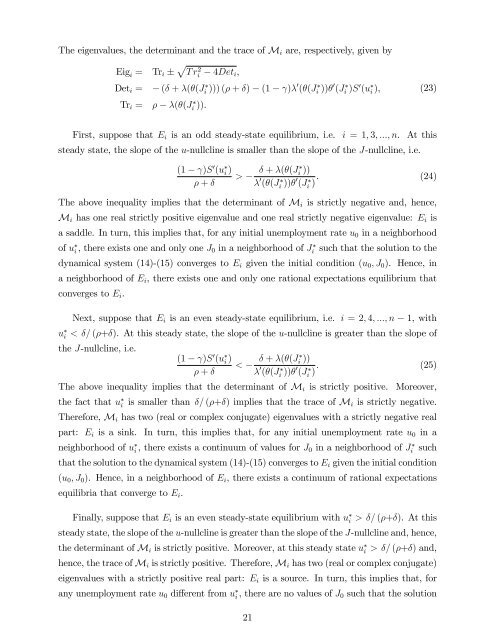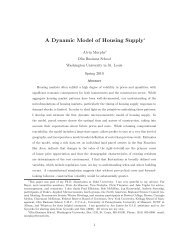Shopping Externalities and Self Fulfilling Unemployment Fluctuations*
Shopping Externalities and Self Fulfilling Unemployment Fluctuations*
Shopping Externalities and Self Fulfilling Unemployment Fluctuations*
You also want an ePaper? Increase the reach of your titles
YUMPU automatically turns print PDFs into web optimized ePapers that Google loves.
The eigenvalues, the determinant <strong>and</strong> the trace of M i are, respectively, given byEig i = Tr i p T r 2 i 4Det i ,Det i = ( + ((J i ))) ( + ) (1 ) 0 ((J i )) 0 (J i )S 0 (u i ),Tr i = ((J i )).(23)First, suppose that E i is an odd steady-state equilibrium, i.e. i = 1; 3; :::; n. At thissteady state, the slope of the u-nullcline is smaller than the slope of the J-nullcline, i.e.(1 )S 0 (u i ) + > + ((Ji )) 0 (24)((Ji ))0 (Ji ).The above inequality implies that the determinant of M i is strictly negative <strong>and</strong>, hence,M i has one real strictly positive eigenvalue <strong>and</strong> one real strictly negative eigenvalue: E i isa saddle. In turn, this implies that, for any initial unemployment rate u 0 in a neighborhoodof u i , there exists one <strong>and</strong> only one J 0 in a neighborhood of Ji such that the solution to thedynamical system (14)-(15) converges to E i given the initial condition (u 0 ; J 0 ). Hence, ina neighborhood of E i , there exists one <strong>and</strong> only one rational expectations equilibrium thatconverges to E i .Next, suppose that E i is an even steady-state equilibrium, i.e. i = 2; 4; :::; n1, withu i < / (+). At this steady state, the slope of the u-nullcline is greater than the slope ofthe J-nullcline, i.e.(1 )S 0 (u i ) + ((Ji ))< + 0 ((Ji ))0 (Ji ):(25)The above inequality implies that the determinant of M i is strictly positive. Moreover,the fact that u i is smaller than / (+) implies that the trace of M i is strictly negative.Therefore, M i has two (real or complex conjugate) eigenvalues with a strictly negative realpart: E i is a sink. In turn, this implies that, for any initial unemployment rate u 0 in aneighborhood of u i , there exists a continuum of values for J 0 in a neighborhood of Ji suchthat the solution to the dynamical system (14)-(15) converges to E i given the initial condition(u 0 ; J 0 ). Hence, in a neighborhood of E i , there exists a continuum of rational expectationsequilibria that converge to E i .Finally, suppose that E i is an even steady-state equilibrium with u i > / (+). At thissteady state, the slope of the u-nullcline is greater than the slope of the J-nullcline <strong>and</strong>, hence,the determinant of M i is strictly positive. Moreover, at this steady state u i > / (+) <strong>and</strong>,hence, the trace of M i is strictly positive. Therefore, M i has two (real or complex conjugate)eigenvalues with a strictly positive real part: E i is a source. In turn, this implies that, forany unemployment rate u 0 di¤erent from u i , there are no values of J 0 such that the solution21
















